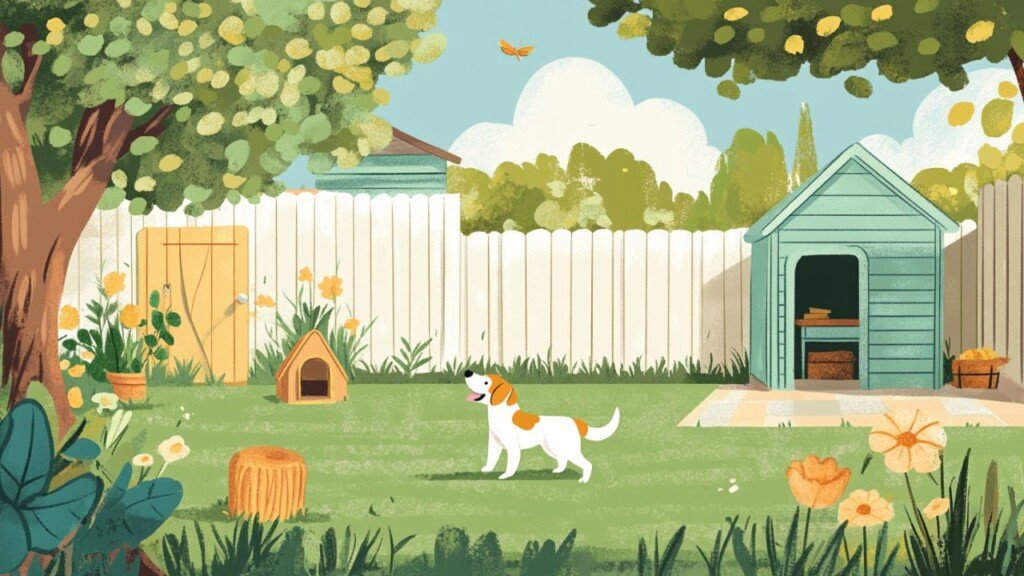As a dog owner, ensuring your furry friend’s safety is a top priority, and that includes creating a secure outdoor environment.
Your yard should be a place where your dog can play, explore, and relax without unnecessary risks.
This guide will walk you through essential steps to transform your yard into a dog-friendly paradise.
Secure the Perimeter
The first step in creating a safe yard is to ensure your dog can’t escape or that unwanted visitors can’t enter.
Inspect your fence for any holes, weak spots, or areas where your dog might be able to dig underneath.
Consider installing a fence at least 6 feet high if you have a large dog or one known for jumping.
For diggers, bury chicken wire at the base of the fence, extending at least 12 inches below the ground.
Remove Toxic Plants
Many common garden plants can be harmful or even fatal if ingested by dogs.
Research all the plants in your yard and remove any that are toxic to dogs, such as azaleas, lilies, and sago palms.
Replace these with dog-friendly alternatives like sunflowers, marigolds, or pet grass.
Create a designated digging area to redirect your dog’s natural digging instincts away from your prized flowerbeds.

Pest Control Precautions
Be cautious with pesticides and fertilizers, as these can be extremely dangerous if ingested by your dog.
Opt for pet-safe, organic alternatives whenever possible.
Store all gardening chemicals, including fertilizers and weed killers, in a secure, inaccessible location.
If you must use chemical treatments, keep your dog off the treated areas for the recommended time period.
Water Safety
If you have a pool, pond, or other water feature, ensure it’s securely fenced off or covered when not in use.
Teach your dog how to safely exit the pool, and never leave them unsupervised around water.
Consider installing a shallow, dog-friendly water feature for cooling off on hot days.
Ensure any standing water is regularly changed to prevent mosquito breeding and potential disease transmission.
Shade and Shelter
Provide plenty of shaded areas where your dog can escape the sun and heat.
Consider installing a doghouse or creating a covered patio area for protection from rain or extreme weather.
Ensure these areas are well-ventilated and easily accessible to your dog at all times.
In hot climates, consider setting up a misting system or kiddie pool for additional cooling options.
Safe Play Areas
Designate specific areas for play and exercise, free from hazards or obstacles.
Remove any sharp objects, small rocks, or sticks that could pose a choking hazard.
Ensure play equipment, such as agility courses or jump hoops, are sturdy and appropriate for your dog’s size and abilities.
Regularly inspect play areas for potential hazards like exposed nails, splintered wood, or worn-out toys.

Avoid Harmful Substances
Keep your yard free from substances that could be harmful if ingested, such as antifreeze, oil, or paint.
Clean up any spills immediately and store these products in a secure location out of your dog’s reach.
Be cautious with compost piles, as decomposing organic matter can contain toxic molds.
Ensure garbage bins are securely covered to prevent your dog from accessing potentially dangerous items.
Insect and Wildlife Considerations
Use pet-safe methods to control insects like fleas, ticks, and mosquitoes in your yard.
Be aware of local wildlife that could pose a threat to your dog, such as snakes or coyotes.
Consider installing motion-activated lights or sprinklers to deter unwanted wildlife visitors.
Keep bird feeders in areas inaccessible to your dog to avoid conflicts with visiting wildlife.
Temperature Management
In hot weather, provide multiple water sources and consider setting up a cooling station with frozen treats.
During cold months, ensure your dog has a warm, dry place to retreat from harsh weather.
Be mindful of hot surfaces like concrete or metal that can burn your dog’s paw pads in summer.
In winter, avoid using salt or chemical ice melts that can irritate your dog’s paws and be harmful if ingested.

Regular Maintenance
Conduct weekly yard checks to identify and address any new safety concerns.
Keep your lawn mowed and free from debris that could hide hazards or harbor pests.
Regularly clean up dog waste to maintain hygiene and prevent the spread of parasites or diseases.
Trim trees and bushes to eliminate hiding spots for pests or potentially dangerous wildlife.
Conclusion: A Safe Haven for Your Furry Friend
Creating a safe yard for your dog is an ongoing process that requires attention and care.
By implementing these safety measures, you’re providing your canine companion with a secure outdoor space to play, explore, and relax.
Remember, every dog is unique, so observe your pet’s behavior in the yard and make adjustments as needed.
A safe yard not only protects your dog but also gives you peace of mind, allowing both of you to enjoy quality outdoor time together.
Want to keep up to date with new animal stories?
Have you implemented any of these safety measures in your yard?
Share this guide on Facebook to help fellow dog owners create safe outdoor spaces for their furry friends!
Let’s work together to ensure all our canine companions have secure and enjoyable outdoor environments to call their own.
Your dog will thank you with wagging tails and joyful barks for creating their very own backyard paradise!
SHARE now with your friends!


